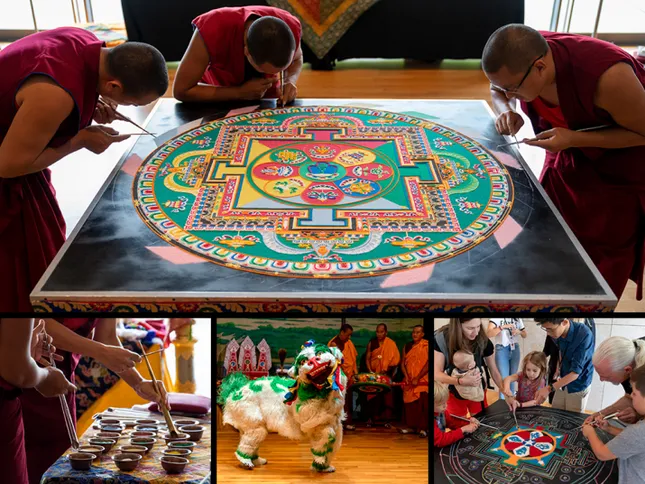In mid-August, Houston, Texas, became a vibrant cultural hub, welcoming monks from the Drepung Loseling Monastery in southern India. The “Mystical Arts of Tibet” program, organized by the Asia Society Texas Center, offered the community a chance to witness unique spiritual practices, a centuries-old heritage of Tibetan Buddhism. This event was not merely an art performance but a cultural bridge, fostering a deeper understanding of a rich Eastern civilization among Texans.
Sand Mandala: Symbol of Enlightenment
The highlight of the 5-day program was the mesmerizing sand mandala demonstration. For over five days, monks meticulously crafted intricate mandalas by pouring millions of tiny grains of colored sand from metal funnels. This process demanded not only skillful dexterity but also intense concentration and patience.

Geshe Tenzin Phentsok explained that the mandala symbolizes the path to enlightenment. The artwork serves as a spiritual map, guiding pilgrims towards the light of truth. Each color, texture, design, and structure within the mandala carries profound meaning, reflecting the noble qualities of enlightenment.
Spiritual Dances and the Message of Impermanence
Alongside the sand mandala, the monks also performed traditional dances, typically showcased in Tibetan spiritual and cultural festivals. These dances are not just art forms but also vehicles for conveying profound Buddhist teachings.
A particularly moving moment was when the monks destroyed the mandala with a single brushstroke. This act symbolized the impermanence of life and all phenomena. The message of impermanence is a core tenet of Buddhism, reminding us to cherish each present moment and avoid attachment to anything.
Sending Wishes with Lungta Prayer Flags
Attendees also had the opportunity to participate in decorating lungta prayer flags. According to Tibetan Buddhist tradition, these flags are hung in high places so that the wind carries prayers and blessings to all directions. Decorating lungta flags together was a way for everyone to collectively send good wishes for themselves, their families, and the community.
The monks also performed zokkay chanting rituals and played traditional Tibetan musical instruments. These sacred sounds created a solemn spiritual atmosphere, helping listeners experience peace and tranquility within their souls.
Asia Society Texas: A Cultural Bridge
Stephanie Todd Wong, Director of Arts and Culture at the Asia Society Texas Center, shared that the program’s goal was to foster mutual understanding between cultures. In an increasingly diverse world, understanding and respecting different cultures is more important than ever.
The Asia Society Texas Center was founded in 1979 by First Lady Barbara Bush and former Ambassador Roy M. Huffington. With 13 locations worldwide, this organization is a leading institution in promoting understanding and strengthening partnerships among peoples, leaders, and institutions of Asia and the West.
The Asia Society Texas Center fulfills its global mission by focusing on local activities, enriching and diversifying the cultural life of Houston through innovative programs in arts, culture, business, policy, education, and community outreach.
The Asian cultural festival in Texas is not just an entertainment event but also an opportunity for local residents to learn about different cultures, broaden their horizons, and build better relationships with the world around them. This event has helped affirm Texas’s role as a diverse cultural center where different civilizations can intersect and integrate.
Conclusion
The Asian cultural festival in Texas, especially the “Mystical Arts of Tibet” program, is a testament to the power of culture in connecting people and building mutual understanding. This event provided Texans with profound spiritual experiences while helping them better understand the unique cultural values of Tibetan Buddhism. It is hoped that similar events will be organized more frequently, further enriching the cultural life of the community and promoting integration among cultures worldwide. What are your thoughts on such diverse cultural events?